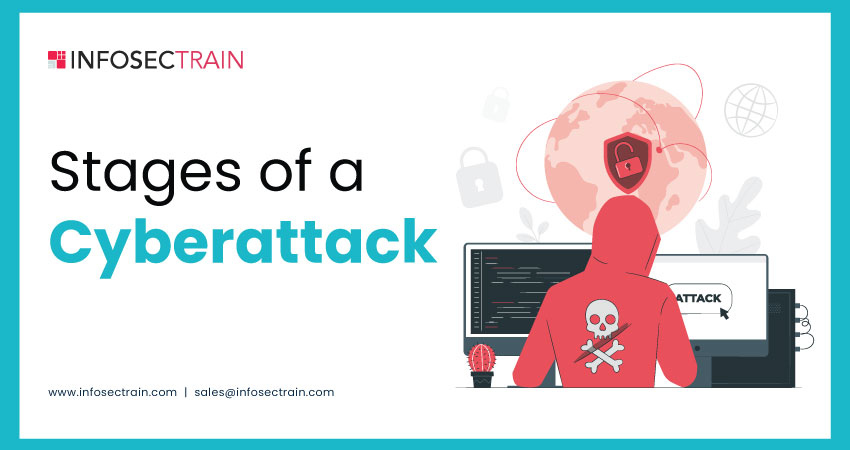Stages of a Cyberattack
With the growing integration of digital technology in every aspect of business operations, the risk of cyberattacks is becoming more significant. Today, all businesses, regardless of size, are vulnerable to cyberattacks as they process and store all valuable information in digital spaces that hackers can try to exploit against them. Cyberattacks have become a pivotal concern for any entity that depends on digital platforms to conduct its operations. These attacks aim to exploit valuable data, disrupt operations, or even hold businesses to ransom. As cyberattacks continue to expand, it is crucial to understand how they are carried out. In this blog, we will cover the 14 stages of cyberattacks and how they work, but first, let us know what a cyberattack is.

What is a Cyberattack?
A cyberattack is an offensive attack performed by cybercriminals or hackers against computer systems, networks, infrastructure, or other digital systems. Cybercriminals attempt cyberattacks with the malicious purpose of obtaining unauthorized access, stealing sensitive or confidential data, or inflicting damage. They use various methods to execute a cyberattack, including phishing, malware, DDoS attacks, ransomware, social engineering, man-in-the-middle attacks, brute force attacks, and more. Cyberattacks can have severe implications for individuals, companies, and governments, leading to financial losses, privacy breaches, and even disruptions to critical infrastructure.
Stages of a Cyberattack
A cyberattack goes through a total of 12 stages. Here, we will cover an overview of each stage.

1. Reconnaissance: The initial stage of a cyberattack is reconnaissance. In this stage, hackers gather intelligence or information on a potential target. They collect data from widely used websites and open sources, including LinkedIn, Indeed, Facebook, Twitter, and more, and determine the best way to exploit it. Their primary objective is to identify active hosts to learn more about the target’s identity, physical location, network address, service provider, etc.
2. Resource Development/Weaponization: Once the hackers have all the target’s information, they move on to the resource development stage. At this stage, the hackers develop methods and tools to penetrate the target. They can compromise the target infrastructure and service accounts by building new capabilities, such as buying or leasing physical or cloud servers.
3. Initial Access: After developing tools and techniques, the hackers will use social engineering, phishing, or brute force attacks to obtain initial access to the target environment. They may also compromise the target supply chain or publicly-facing assets.
4. Execution: Once hackers have gained access to the target environment, they can efficiently execute their malicious code into the target environment using the tools they have designed and exploit native containers, APIs, services, or shared modules.
5. Persistence: In this stage, the hackers maintain continuous access to the target environment without interruptions like credential changes or restarts. On the target network, they will install a persistent backdoor, set up an admin account, and disable firewalls. They will next take action to perform privilege escalation.
6. Privilege Escalation: In the privilege escalation, hackers acquire higher access levels within a computer system or network to make further changes. This allows them to perform actions that are usually restricted to administrators or other users with higher permissions.
7. Defense Evasion: In this stage, the hackers use defense evasion techniques to avoid detection throughout their compromise and continue their malicious activities without raising suspicion. These techniques include uninstalling or disabling security software, deleting logs, and obfuscating or encrypting data and scripts.
8. Lateral Movement: During this stage, the hackers penetrate the target environment more deeply. In order to track more sensitive information, valuable intellectual property, and other high-value assets, they pivot from the initially hacked system to other systems in the target environment.
9. Collection: At this stage, when the hacker is fully embedded in the target environment, they can gather high-value assets, including financial data, Personally Identifiable Information (PII), intellectual property like trade secrets or product designs, and so forth.
10. Command and Control: Now, hackers have unrestricted access and the ability to install “command and control” malware. In this stage, they can issue commands to establish connections and carry out their attack strategy. Their target network, system, and application are now effectively under their control. This enables them to communicate and control infiltrated systems through data encoding, encrypted channels, and exploited application protocols.
11. Exfiltration: In this stage, the hackers will copy or transfer the collected data from the compromised target system to an external location. This stage often marks successful cyber attacks, where the hackers finally achieve their goal of obtaining valuable or sensitive information.
12. Impact: This is the final stage of a cyberattack, where hackers can corrupt or destroy sensitive and confidential data, modify configurations, or prevent services from being available.
Implementing cybersecurity measures across every organization is now more essential than ever because of the rise in cyberattacks. Cybersecurity is the practice of protecting critical infrastructure and personal information from cyberattacks using technology and processes.
How can InfosecTrain help?
InfosecTrain is a renowned training and consulting company specializing in cybersecurity and IT security training and services. If you are new to cybersecurity, enroll in our CompTIA Security+ certification training course. You can also enroll in our Cybersecurity Orientation Program, an introductory course for beginners who are entirely new to cybersecurity. These courses are tailored to help beginners gain the knowledge and skills to begin a career in , supported by expert instructors and comprehensive materials. Join InfosecTrain to start your journey into the world of cybersecurity.
TRAINING CALENDAR of Upcoming Batches For Security+ SY0-701
| Start Date | End Date | Start - End Time | Batch Type | Training Mode | Batch Status | |
|---|---|---|---|---|---|---|
| 12-Apr-2025 | 25-May-2025 | 19:00 - 23:00 IST | Weekend | Online | [ Open ] | |
| 25-May-2025 | 05-Jul-2025 | 19:00 - 23:00 IST | Weekend | Online | [ Open ] |







 1800-843-7890 (India)
1800-843-7890 (India)